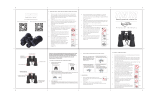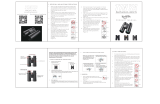CARSON LIFETIME LIMITED WARRANTY
This Carson product is warranted to be free from defects in material and workmanship. Carson will, at its option and without
charge, either repair any part or assembly of parts found to be defective in material or workmanship, or replace this Carson
product with a Carson product of comparable value and condition, subject to the limitations and exclusions noted herein.
This warranty extends to the original purchaser only and is not assignable or transferable. It shall not apply to any product
that has been subject to misuse, abuse, negligence or accident, or to any defects or damage directly or indirectly caused by
the use of unauthorized replacement parts and/or service performed by unauthorized personnel.
This warranty gives you specific legal rights, and you may also have other rights which could vary from state to state.
Some states do not allow limitations on the life of an implied warranty and/or do not allow excluding or limiting incidental
or consequential damages. If so, the above limitations or exclusions may not apply to you.
WARRANTY PROCEDURE
Provide proof of purchase. A receipt or other dated proof of purchase must be included with merchandise being returned
for a warranty claim to be processed.
Call or write for authorization. Before returning any product for a warranty claim, a Return Authorization (RA) number
must be obtained. No merchandise will be accepted without an RA, and failure to obtain an RA will prevent or delay
processing of the warranty claim. To obtain an RA call 631-547-5000, or write to Carson Warranty Service, 35 Gilpin Avenue,
Hauppauge NY 11788-4723 with a description of the problem. Include your name, address and telephone number.
Package the return carefully. Shippers will not reimburse for damages due to insufficient packaging, even if the
merchandise is insured. Print the RA number prominently on the top of the package.
Prepay shipping. Insure the package. Send it to Carson Warranty Service, 35 Gilpin Avenue, Hauppauge NY 11788-4723,
together with a check in the amount of $12.00 to cover the cost of handling. Merchandise must be shipped prepaid.
Carson will not accept merchandise C.O.D.











